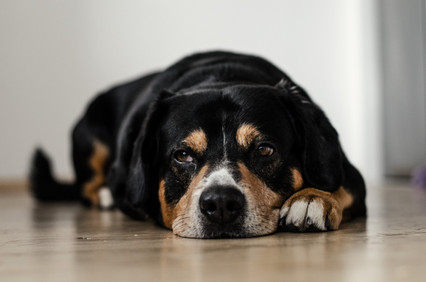Can Dogs Get Lice?

Yes, dogs can get lice. To get rid of them, like for humans, it’s going to take a thorough treatment. Before you start ridding your dog of lice, first you have to figure out if in fact your dog has lice as opposed to some other skin irritation. Secondly, you have to figure out what kind of lice is attacking your animal and then you have to find the right dog shampoo to get rid of the live lice as well as the tiny lice eggs.
How to Tell if Your Dog Has Lice
If there is a lice outbreak in your house among the humans, don’t blame your dog. They can’t give it to you and you can’t give it to them. Lice that suck human blood don’t suck dog blood and the reverse is true as well.
Besides, not all lice are suckers; some are biters. The first step to determining whether or not your dog has lice is to know what to look for.
Human Lice and Dog Lice are Not the Same
Wherever we grow hair, we can get lice. Animals covered in fur like your dog are susceptible to the same type of parasites which burrow into your hair follicles and live off of your scalp flakes and oily skin. But we are not susceptible to the same parasites.
Dog lice come in two main varieties – biters and bloodsuckers. Bloodsucker lice (aka the linognathus setosus louse), as implied, suck your blood just like human lice. Dogs have to deal with a second kind of louse called the trichodectes canis (the more common one in America) which bites dogs, feeding off of their dry skin and dander.
Just by playing together at recess, your child can get lice from contact with other kids. Human lice can hop from one head to the other. Dog lice don’t hop. They are usually spread where dogs are penned in together like in kennels, sleeping in the same bedding or crates, or rolling around together at a dog park.
Mangy Dogs are Most Susceptible to Lice
Frankly the more disheveled a dog is the more susceptible it is to lice. Dogs that are so neglected that the fur is matted from lack of grooming or where they are suffering from malnutrition, dehydration, and general lack of care are the ones that typically get lice.
What to Look for (Detecting Dog Lice)
It can be difficult to differentiate lice from other itches that dogs get. Your dog doesn’t have to be sick or dirty to scratch. So how can you tell if your dog’s itching is being caused by a lice infestation? Itching is just one of the symptoms.
Symptoms of Dog Lice:
Start checking your dog for lice by doing an inspection with your necked eye. The places where you are likely to see lice congregated are around your dog’s ears, the scruff of their neck, their genitalia, and on top of their head. Those areas may be suffering from some or all of these symptoms when lice are present:
- Incessant Scratching
- Redness
- Swelling
- Pain with Irritation
- Stiff or Coarsened Patches of Hair
- Noticeable Hair Loss
- Bald Patches
- Bite Marks at Affected Spots
If your dog is being attacked by the bloodsucking variety of lice, the longer an infestation goes on the greater the chances your dog will develop worse symptoms like anemia and bacterial infections spread by lice. If your dog starts losing weight rapidly and shows signs of lethargy, it could be suffering from anemia and malnutrition due to a lice infestation.
Dog Lice Looks Like:
Think of a beetle with the legs of an ant and now shrink it down to the size of a speck of brown dirt. That is your basic adult louse. If your dog is suffering from an infestation, it is probably going to have lice in all three stages of life from egg to larva to adult.
Louse eggs are so tiny that they are almost impossible to see without a microscope. They are sometimes white and sometimes yellow and can be confused with pet dandruff. When they are teenagers in their larva phase, lice get a little bit bigger, about the size of a needle point.
Adult lice are easily mistaken for dirt because they turn brown or tan. In a clump they are much easier to see. You’ll see them in one of those phases wrapped around the shaft of your dog’s fur or crawling on the skin.

Treating a Dog Lice Infestation
Bloodsuckers will dig into the scalp and stay or burrow. The biting kind will crawl around on your dog’s skin, although they are less irritating and dogs itch less when infested with biting lice. You can see these easier in the same way you can see lice crawling on a human scalp.
You’ll need a flea brush or comb to finely go through your dog’s fur, looking down the hair shafts to the scalp for signs of nits, larva, or adult lice. If you see white specks along the fur shaft that look like dandruff, whisk your hands through the fur. If you see dandruff fly off, it’s not lice. If the white stuff sticks, they are probably nits.
Just like in humans, you’ll have to do repeated treatments to get rid of dog lice. Over their entire life cycle lice live for about a month. Once an adult hatches eggs, they will keep reproducing, growing, and dying until the infestation is treated.
For an infestation, you want to go to the vet so that you can get a prescription for a safe insecticide. You may have to administer doses of the medicine for up to a month or longer. Most lice treatments can be applied directly to the skin and fur.
How to Prevent Your Dog from Getting Lice
Some lice infestations are inevitable. You go on a trip and have to kennel your dog, they come into contact with a dog with lice, and your dog comes home infected. There are many things that you can do to prevent your dog from getting lice. Here are the best ways to prevent it:
Dispose or Sanitize Infested Areas
Before you let your dog back in the house after the first treatment for lice, you have to clean and or dispose of your dog’s bedding. That includes their toys, their portable crates, their dog beds—everything. Whatever you can’t or don’t want to throw away you have to sanitize.
Include all of your dog’s dishes and things that can’t be washed in a bag and freeze it for a day. Not even louse eggs can survive freezing cold. Make sure to wash and disinfect your dog brushes, buy them a new collar, and perhaps replace their sleeping pad.
Inspect for Lice Regularly
Proper grooming for your dog requires at least a weekly brushing. Long haired dogs require even more frequent grooming. As part of all dog grooming routines, you should add lice inspection to your list of chores, especially in warm climates and temperatures.
In the same way that you look for ticks and fleas after a camping trip or a walk in the park, be sure to look for nits and lice too. Make it a weekly thing to stop a full blown infestation in its tracks.
Get Your Dog Flea Dipped
If your dog is part of a doggie group where it socializes regularly with other dogs, alert the other pet owners of dogs with which your dog has been in contact over the last month. Let them know that you are treating the infestation and keep your dog away while still being treated.
Next, you want to keep your dog nit and lice free by going to the vet for a professional flea dip every month or so. Though the chemicals are aimed at preventing flea infestations, there is evidence that flea dips and flea collars actually stave off lice infestations too.
Eye Envy’s Dog Shampoos Keep Dogs Lice Free
After your dog has been given the all clear, you don’t want to have to go through all of this again. You can keep your dogs lice free by using a quality dog shampoo that uses natural antibiotics to control the spread of bacteria while maintaining your pet’s natural oils.
Eye Envy’s line of dog shampoos contains one of the best solutions to date for preventing infestations naturally. Instead of using harsh chemicals or antibiotics that create resistance in your dog, Eye Envy’s dog shampoos carefully balance your dog’s chemistry for an effective and safe cleanser.

